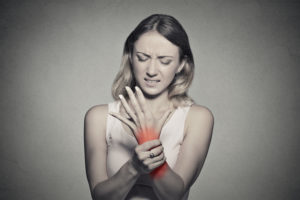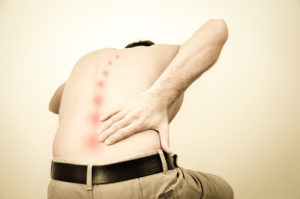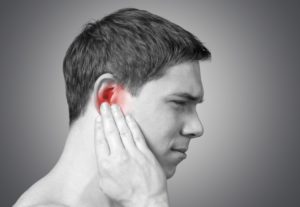Common Conditions We Can Help With

Digestive Problems
Researchers Discover Possible Link Between Crohn’s Disease and Spinal Problems
According to a recent study, researchers in Japan say there is a possible link between Crohn’s disease and interference to the nervous system from spinal misalignments.
The research was published in the Journal of Vertebral Subluxation Research and grew out of a previous study involving more than 3,000 patients with allergic diseases and over 1,000 non-allergic patients. It focused on the relationship between immune function, spinal displacements called vertebral subluxations, and how reducing those displacements resulted in improvement, and in some cases complete remission, of symptoms of Crohn’s disease.
Crohn’s disease causes inflammation in the small intestine but it can affect any part of the digestive tract, from the mouth to the anus. The inflammation causes pain and makes the intestines empty frequently, resulting in diarrhea.
There are many theories about what causes Crohn’s disease but none has been proven. The most popular theory is that the body’s immune system reacts to a virus or a bacterium by causing ongoing inflammation in the intestine.
Treatment for Crohn’s disease includes corticosteroids to control inflammation but while these drugs are considered the most effective for active Crohn’s disease, they can cause serious side effects, including greater susceptibility to infection. Immune suppressing drugs are also used to treat Crohn’s disease.
According to Dr. Yasuhiko Takeda, a chiropractor and lead author of the study: “This is why it is so important to develop other means of dealing with this terrible disease. If we can find treatments that enhance the function of the immune and nervous systems perhaps we can help millions of people with this disease without the harmful side effects of drugs.”
Beginning in 1992, the focus of Takeda’s research has been on the relationship between subluxation, allergic disease, asthma, Crohn’s disease, irritable bowel disorder and ulcerative colitis. He became interested in this after observing common patterns of spinal distortions and subluxation in patients presenting with these problems. He observed that many of these people got better following chiropractic care. This convinced him that chiropractic care was the answer to these health problems and that he needed to look into it in more detail.
As Takeda pointed out, “Allergic diseases are a large group of disorders that include: pollinosis, allergic rhinitis, atopic dermatitis, hay fever, bronchial asthma, drug allergies, Crohn’s disease and inflammatory bowel disease to name a few. In Japan alone these diseases affect tens of millions of people. It affects their quality of life in terms of physical strength, immune deficiency, and autonomic imbalance. It doesn’t stop there as it affects their social well-being, schoolwork and on the job productivity. You must also consider the terrible side effects of the steroid medications and immunosuppresants that are given to treat these patients.”
While the results are exciting, more research is needed, according to Dr. Matthew McCoy, Editor of the Journal of Vertebral Subluxation Research. “Clearly the results of Dr. Takeda’s study are something to be excited about and they are not surprising considering other research that shows improved immune and nervous system function following chiropractic care,” stated Dr. McCoy.
Chiropractors correct misalignments and related problems of the spine that interfere with how the nerves work. These problems in the spine are called vertebral subluxations and can be corrected by chiropractors with painless adjustments to the affected spinal bones.
Other Digestive Disorders
Including: Irritable Bowel Syndrome, Kidney, Incontinence, Interstitial Cystitis.
The types and frequencies of nonmusculoskeletal symptoms reported after chiropractic spinal manipulative therapy. Leboeuf-Yde C, Axen I, Ahlefeldt G, et al. J Manipulative Physiol Ther. 1999:22(9):559-564.
Twenty consecutive patients from 87 Swedish chiropractors answered questionnaires on return visits. A total of 1,504 questionnaires were completed and returned. Twenty-three per cent of patients reported improvement in nonmusculoskeletal symptoms, including:
Easier to breathe (98 patients)
Improved digestive function (92)
Clearer/better/sharper vision (49)
Improved circulation (34)
Less ringing in the ears (10)
Acne/eczema better (8)
Dysmenorrhoea better (7)
Asthma/allergies better (6)
Sense of smell heightened (3)
Reduced blood pressure (2)
Numbness in tongue gone (1)
Hiccups gone (1)
Menses function returned (1)
Cough disappeared (1)
Double vision disappeared (1)
Tunnel vision disappeared (1)
Less nausea (1)
Case study: three year old female with acute stomach problems. Peet JB Chiropractic Pediatrics, 1997;310-11.
This is the case study of a 3 year-old with acute stomach complaints including indigestion and pain that started after a fall off her bed onto the floor. After the fifth visit all of her symptoms resolved.
L5 subluxation: a cause of interstitial cystitis. Hammer W. Dynamic Chiropractic, 1997 (April 7):14.
This is the case of a 28-year-old male who suffered from frequent urination, perineal pain and mild low back and buttock pain. An MRI confirmed a lateral L5 disc bulge and a fixation at L5/S1. After two adjustments to the 5th lumbar vertebrae the patient’s pelvic and urological symptoms disappeared. The paper below discusses the same condition but because the authors are MDs they corrected the problems using surgery.
Lumbar nerve root compression and interstitial cystitis – response to decompressive surgery. Gillespie, L, Bray R, Levin R. British Journal of Urology, 1991;68;361-364.
This paper discusses ten patients with interstitial cystitis (nine females, one male). MRI revealed nerve compression at L5 and after surgery the symptoms in 9 of the 10 cleared up.
The mechanically induced pelvic pain and organic dysfunction syndrome: An often overlooked cause of bladder, bowel, gynecological, and sexual dysfunction. Browning JF. Journal of the Neuromusculoskeletal System 1996; 4:52-667
Pelvic pain and organic dysfunction (PPOD) syndrome is thought to be caused by a lumbar spine problem causing secondary impairment of lower sacral nerve root function. Patients report bladder, bowel, gynecologic and sexual dysfunction.
This is the case of a 29 year-old woman with bilateral and low back pain. Previous chiropractic care gave partial relief but an exacerbation was accompanied by inguinal pain, urinary stress incontinence, loss of genital sensitivity, loss of libido and vaginal discharge. A gynecological exam failed to reveal any pathology.
Lower sacral nerve root involvement, secondary to a L5/S1 disc herniation was found. After the first adjustment the patient initially experienced symptoms (pain and paraesthesia of the genitalia) but within one week, bladder dysfunction had resolved, and the other symptoms were less severe. After 4 weeks, all her PPOD symptoms had resolved.
Lumbar nerve root compression and interstitial cystitis-response to decompressive surgery. Gillespie L, Bray R, Levin N, Delamarter R. British Journal of Neurology, 68:361-364, 1991.
This paper describes nine females and one male who were diagnosed with interstitial cystitis. They described their pain as “severe.” MRI of the lower spine found a lateral compression of the L5 dorsal nerve root. Surgical decompression of the lateral foramina of L5 resulted in immediate relief of urological pain in nine patients and continued symptom free after a six-month follow-up.
As the authors state: “An identifiable lumbar nerve root compression appears to cause urological dysfunction consistent with interstitial cystitis.”
Indigestion and heartburn: a descriptive study of prevalence in persons seeking care from chiropractors. Bryner P and Staerker, PG. Journal of Manipulative and Physiological Therapeutics 1996; 19(5); 317-23.
1,567 persons who consulted eight chiropractors on 2,974 occasions during November 1994 were surveyed. 57% reported indigestion infrequently or more, 71% reported mid-back pain during the previous 6 months and 46% experienced both symptoms during this time. 22% of those with indigestion reported some relief after chiropractic care.
Segmental spinal osteophytosis in visceral disease. Burchett GD J of the American Osteopathic Association 1968; 67(6): 675.
Sixty-one hospital patients were examined and in 88% of patients with gallbladder disease there was lipping from T7-T10; spinal osteophytes (T9-T11) were found in 82% of those with stomach disease. Many sufferers of pancreatic disease had segments T5-T7 involved and 31% of patients with duodenal disease had osteophytes at T9-L2.
Irritable bowel syndrome and spinal manipulation: a case report. Wagner T, Owen J, Malone E, Mann K. Chiropractic Technique 1996; 7: 139-140.
Irritable bowel syndrome, also known as mucous colitis and nervous bowel affects 15-25% of adults. Symptoms include cramping and/or abdominal pain, diarrhea or constipation, ulcer-type symptoms, heartburn and/or upper abdominal indigestion.
In this case study of a 25-year-old woman with chronic irritable bowel syndrome her chief complaint was intestinal pain and diarrhea which was worse during stressful periods which occurred one or two times per week for the past five years.
After her first chiropractic adjustment, she reported that she had not experienced any diarrhea for two days. Her symptoms were quickly alleviated during the course of her care. Two years later she remained symptom free.
Enuresis, spasmodic dysmenorrhea and gastric discomfort: a vertebral subluxation complex entity. Regan KJ Digest of Chiropractic Economics March/April 1990;32(5):110.
Patients suffering from bed-wetting, menstrual cramps and ulcer pains/indigestion were given chiropractic care. MDs performed pap tests, pelvic exams and upper GI studies and were negative for active pathology. One subject did have a true peptic ulcer and demonstrated a desire to be in the study.
“A total of eight subjects in each category were selected and two in each category were not treated (to be used as control studies)..It should be noted here that no one had any low back, dorsal or cervical spine pain prior to being a patient in this program.
“In the dysmenorrhea category, all cases of pelvic pain and severe cramping of the uterus had stopped. All women experienced three menstrual cycles through the duration of their menses. “The bedwetting category demonstrated 50% of the children had stopped bedwetting early in the program, 25% of the children had a 50% reduction in the frequency of occurrences and 25% showed no improvement.
All the patients in the gastric category except one responded to chiropractic care; no one was taken off medication or put on special diet.”
Chiropractic adjustment in the management of visceral conditions: a critical appraisal. Jamison JR, McEwen AP, Thomas SJ. Journal of Manipulative and Physiological Therapeutics, 1992; 15:171-180.
In this a survey of chiropractors in Australia, more than 50% of the chiropractors stated that asthma responds to chiropractic adjustments; more than 25% felt that chiropractic adjustments could benefit patients with dysmenorrhea, indigestion, constipation, migraine and sinusitis.
The recognition of mechanically induced pelvic pain and organic dysfunction in the low back pain patient. Browning JE. Journal of Manipulative and Physiological Therapeutics, 1989,12(5):369-373.
Pelvic organic problems that have been shown to respond to manipulative treatment include impairment of bladder, bowel and sexual function.
The side effects of the chiropractic adjustment. Burnier, A Chiropractic Pediatrics Vol. 1 No. 4 May 1995.
This is a case history of J.C. male, 1 year old. The child was diagnosed by a gastroenterologist with post-viral enteritis, c.difficile enteritis, colitis secondary to antibiotic usage, allergic colitis, gastroesophageal reflux with esophagitis, gastric and/or duodenal ulcer disease, duodenitis secondary to congenital or autoimmune phenomenon and club feet requiring surgery. He was on Amoxicillin T, Zantac T, Reglan T, Tylenol T, and Ambesol T.
Subluxation at Occiput/C1 with an Atlas ASRP, Sacrum base posterior.
Original Adjustments: Left occiput ridge meningeal contact for 30 seconds, double notch sacral meningeal contact for 1 minute; structural manual adjustment of Atlas ASRP, left temporoparietal suture adjustment.
Results: Off all medication after first visit. Immediate improvement within 24 hours. Complete resolution within 3 weeks of care. Six months later the child is in radiant health, has had no need for medical care and has been free of medication and over-the-counter drugs. Club feet straightened out without surgery within 1 1/2 months of care.
CORPORATE WELLNESS SOLUTIONS FOR COMPANIES IN THE DFW METROPLEX
Copyright © 2017 The Corporate Chiropractor | All Rights Reserved









